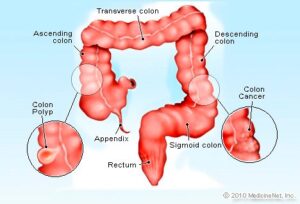Colon Cancer
Everything you need to know about colon cancer

Symptoms
- Stages
- Causes
- Risk factors
- Treatment options
- Diagnosis
- Prevention
- Outlook
- Summary
Colon cancer develops when tumorous growths form in the large intestine. It is now the third most common type of cancer in the United States.
The colon, or large intestine, is where the body draws out water and salt from solid waste. The waste then moves through the rectum and exits the body through the anus. Rectal cancer originates in the rectum, the final several inches of the large intestine, closest to the anus.
Colorectal cancer, which describes co-occurring colon cancer and rectal cancer, is common.
According to the American Cancer Society (ACS)Trusted Source, colorectal cancer is the third most commonly diagnosed cancer in the U.S., aside from skin cancers. In 2021, the ACS predicts that 104,270 people in the U.S. will receive a new diagnosis of colon cancer.
Healthcare professionals recommend regular colorectal cancer screenings for adults aged 45–75Trusted Source.
In this article, we look at how to recognize and treat colon cancer, why it develops, and how to prevent it.
Sex and gender exist on spectrums. This article will use the terms “male,” “female,” or both to refer to sex assigned at birth. Click here to learn more.
Symptoms and signs of colon cancer
- Diarrhea or constipation
- Changes in stool consistency, such as loose, narrow stools
- Blood in the stool, which may make stools appear dark brown or black
- Bright red bleeding from the rectum
- Abdominal pain, cramping, bloating, or gas
- Continual urges to defecate despite passing stools
- Weakness and fatigue
- Unexplained weight loss
- Irritable bowel syndrome
- Iron-deficiency anemia
Weight loss and abdominal pain usually occur in the later stages of the disease.
If cancer spreads to a new location in the body, such as the liver, it can cause additional symptoms, such as jaundice.
Early symptoms
Colon cancer often causes no symptoms in the earliest stages, but symptoms may become more noticeable as the disease progresses. If people do have symptoms in the early stages, they may include:
- Blood in the stool
- A change in frequency or type of bowel movements, such as diarrhea, constipation, or narrow, ribbon-like stools
- The feeling of not emptying the bowels after a bowel movement
- Abdominal pain, cramping, or bloating
- Nausea and vomiting
- Anemia, due to intestinal bleeding
- Loss of appetite
- Fatigue and weakness
- Unexplained weight loss
Symptoms in males
According to Brigham and Women’s Hospital, symptoms of colon cancer usually appear the same in males and females. Males may notice the symptoms listed above.
Symptoms in females
Females may experience the same symptoms as listed above. In addition, if people who are menstruating have anemia from colon cancer, they may have irregular menstrual cycles.
Stages
There are different ways of assigning a stage to cancer. The stages indicate how far cancer has spread and the size of any tumors.
Stage 0: Also known as carcinoma in situ, at this point, the cancer is in a very early stage. It has not grown farther than the inner layer of the colon and will usually be easy to treat.
Stage 1: Cancer has grown into the next layer of tissue.
Stage 2: Cancer has reached the outer layers of the colon but has not spread beyond the colon.
Stage 3: Cancer has grown through the outer layers of the colon and reached one to three lymph nodes. It has not spread to distant sites.
Stage 4: Cancer has reached other tissues beyond the wall of the colon. As stage 4 progresses, colon cancer reaches distant parts of the body.
Learn about the outlook for stage 4 colon cancer here.
Causes
- Usually, cells follow an orderly process of growth, division, and death. Cancer can develop when cells grow and divide uncontrollably and do not die at the normal point in their life cycle.
- According to the ACS Trusted Source, researchers are unsure of the exact cause of colon cancer, but certain factors may increase the risk.
- Cancer happens as a result of changes in DNA within cells. Certain genes called oncogenes help cells stay alive, grow, and divide. Tumor suppressor genes help regulate cell division and cell death.
- Changes to DNA can affect oncogenes and tumor suppressor genes, resulting in multiple gene changes that may lead to colon cancer.
- Polyps are growths that form on the inside of the colon. Polyps are noncancerous, but cancer can begin with some types of polyps.
- If a person has a type of noncancerous polyp called an adenomatous polyp, they have an increased risk Trusted Source of developing colon cancer. These polyps form on the inner walls of the large intestine.
- Cancerous cells may spread from malignant tumors to other parts of the body through the blood and lymph systems.
- These cancer cells can grow and invade healthy tissue nearby and throughout the body in a process called metastasis. The result is a more serious, less treatable condition.
